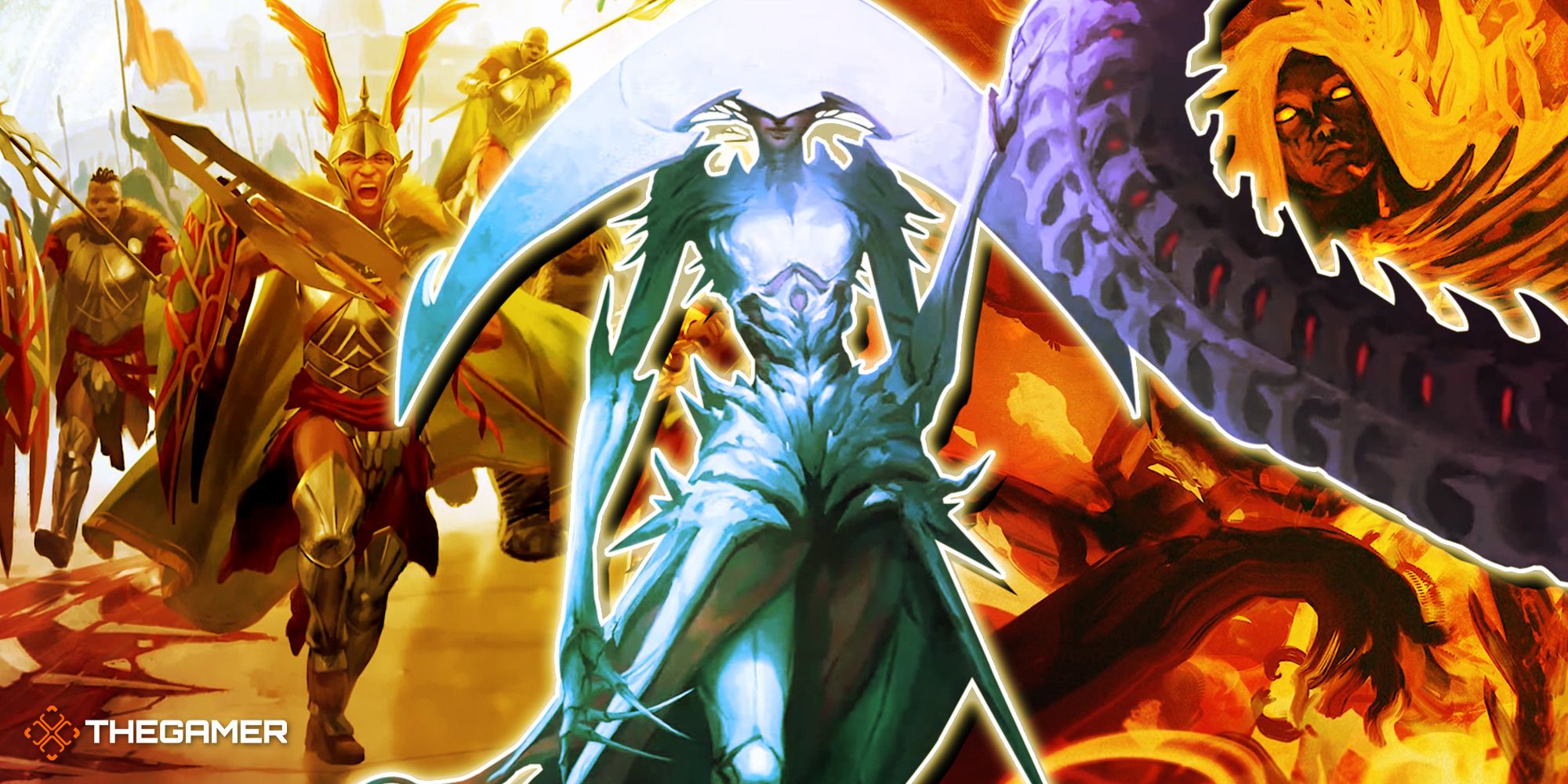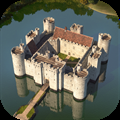Everything Revealed At Magic: The Gathering's March Of The Machine Debut

Quick Links
- New Mechanics
- Returning Mechanics
- Alt-Art Styles
- Multiverse Legends
- Commander Face Cards
- Planechase Cards
Magic: The Gathering has finally lifted the lid on its massive conclusion Elesh Norn’s Phyrexian invasion of the Multiverse. March of the Machine brings to a close a story that has been years in the making, and with a set that spans almost every plane, we need plenty of new mechanics to go with them.
RELATED: Magic: The Gathering – Who Is Urabrask?
Revealed through the Debut stream and subsequent Weekly MTG stream hosted by Blake Rasmussen, we saw everything from new card types to returning mechanics. Here is everything revealed for March of the Machine in its debut.
New Mechanics
Elesh Norn by Magali VilleneuveMarch of the Machine is a huge set, with perhaps the biggest spread of mechanics seen in a Standard set in recent memory.
Battle
Easily the biggest new mechanic of March of the Machine are battle cards. Teased on Atraxa, Grand Unifier in Phyrexia: All Will Be One, battle cards are the first new card type since Planeswalkers were introduced back in 2007.
The first subtype of battles to be introduced are Sieges. Battles are expected to be a regular fixture in future sets with new subtypes, although March of the Machine will only include Sieges.
Siege cards enter the battlefield with a number of defence counters equal to the number in the bottom right. When it enters, you then choose an opponent to be tasked with protecting that Siege from damage. You maintain control of the permanent, but another player has the duty of preventing damage being dealt to it.
Invasion Of Alara by Mathias KollrosLike Planeswalkers, you can attack battle cards directly with your creatures. However, you can also deal direct damage to Sieges through spells that either specify battles as legal targets, or say “any target”.
Any damage a Siege takes makes it lose that many defence counters. Then, if you or any other player manages to remove the final counter from the battle, it is defeated and goes into exile, where you can cast the transformed other side without paying its mana cost. For example, Invasion of Fiora brings back Fiora from the Conspiracy sets, and will transform into Marchesa, Resolute Monarch when it takes four damage.
We’ve already seen lots of battle cards, with March of the Machine including 36 Sieges – each a different plane.
Backup
To represent the people of the multiverse coming together against the Phyrexians, we have the backup mechanic.
When a creature with backup enters the battlefield, you put a specific number of +1/+1 counter on a target creature. If that creature isn’t the one with backup that just entered, that creature then also gains all of the abilities underneath backup for the rest of the turn.
For instance, Boon-Bringer Valkyrie has backup 1, meaning it puts one +1/+1 counter on a creature. If you choose to put it on the Boon-Bringer itself, nothing else happens. If you choose to put the counter on another creature, that creature gains Boon-Bringer Valkyrie’s flying, first strike, and lifelink until the end of the turn.
It’s important to note that backup only copies over the abilities written on the card itself. If your creatures have any other abilities, such as something giving it trample, those will not be shared with the other creature for that turn.
Incubate
The final new mechanic is incubate, to reflect the Phyrexians’ creeping influence across the multiverse.
Whenever a card tells you to incubate, you create an Incubator token with +1/+1 counters equal to the incubate number on the original card. So, for example, Traumatic Revelation has incubate 3, and so the token you make gets three +1/+1 counters.
By paying two mana, you can transform that Incubator token into a 0/0 Phyrexian artifact creature. This token doesn’t leave the battlefield, meaning it retains the counters you put on the Incubator, effectively making a 3/3 Phyrexian artifact creature token.
This is the first time Magic has explored double-sided tokens that transform, but the mechanic itself is very similar to Blood, Food, Clue, Treasure, and Gold tokens we’ve had for ages. The only difference is Incubators become creatures, instead of giving you other resources.
RELATED: Magic: The Gathering - The Best Sagas
Returning Mechanics
Pyre of the Worldtree by Bryan SolaAs mentioned, March of the Machine is making use of a huge number of mechanics from Magic’s past to bring together each plane. However, a few will show up more frequently than others.
Convoke
Found both in the main set and as a major theme of one of the five Commander decks, convoke allows you to pay for spells by tapping creatures instead of paying generic mana.
Usually associated with the white/green Selesnya Conclave on Ravnica, convoke will instead primarily be found in red and blue in March of the Machine, as its primary draft archetype. This means you can expect not just lots of spellslinging, but maybe also ways to make token creatures ready to tap to cast them.
Transform
The Phyrexians seek to convert everything to their own, twisted idea of life, and so it only makes sense for transformation to be an integral part of the set.
In March of the Machine, transforming double-faced cards will be used to showcase creatures being compleated. Transformation will generally be an activated ability, with the mana cost including a Phyrexian mana symbol (which can be paid either with one of the colour, or two life) to showcase which of the five Praetors was responsible for their corruption.
For example, Ixalan’s Etali is seen here as Etali, Primal Conqueror. By paying nine generic and one green Phyrexian mana, it transforms into Etali, Primal Sickness, a Phyrexian Elder Dinosaur with trample, indestructible, 11/11 stats, and the ability to deal up to 11 poison counters in one attack.
Transforming creatures looks like it will be incredible expensive, but the payoff for doing so will be huge. Of course, there is another type of transforming card found in the set, too: Sagas.
Sagas
Last seen in Dominaria United, Sagas are one of Magic’s most popular mechanics. Here, they’re being used to represent the five Praetors of Phyrexia and their core philosophies.
We saw Jin-Gitaxias and The Great Synthesis in the sneak preview a few weeks ago, but today we were shown Elesh Norn, and her Saga, the Argent Etchings. The powerful thing about these five Praetors is that, when the Saga side is complete, instead of sacrificing itself like a normal Saga, it instead transforms back into the creature side, ready to be transformed again to start the whole sequence over.
We can expect there to be five Sagas in the set, for Elesh Norn, Jin-Gitaxias, Sheoldred, Urabrask, and Vorinclex.
Alt-Art Styles
As we saw at the sneak preview event, March of the Machine is bringing back a huge number of old Showcase styles from previous sets. The Storybook style from Eldraine, the Nyx style from Theros, and even the art deco frame from New Capenna have already been revealed.
We also saw Ixalan, which didn’t have a Showcase frame, receive a new one with a golden coin aesthetic. In the debut, we were introduced to two more new showcase frames, with Ravnica’s Borborygmos and Fblthp receiving a cityscape-inspired frame, while Tarkir’s Zurgo and Ojutai getting a new, blade-styled black and white treatment.
It was confirmed that we’ll be seeing 15 total styles in March of the Machine. With the majority already revealed (we can expect every set-specific showcase frame to return), it’ll be interesting to see which older planes also receive their own styles in the days to come.
Multiverse Legends
Another thing we saw at the sneak preview were Multiverse Legends, a bonus sheet that sees legendary creatures from across Magic’s history slotted into booster packs. This is similar to the retro frame reprints we had in the Brothers’ War and the Mystical Archive from Strixhaven, albeit creature-focused instead.
11 more legendary creatures were shown off, with reprints of all five of the original Phyrexian Praetors confirmed to be receiving All Will Be One’s Ichor style, alongside other faces like Yargle, Glutton of UIrborg; Skythrix, the Blight Dragon; Zada, Hedron Grinder; and Niv-Mizzet Reborn, also in that new Ravnica showcase frame.
Every booster pack will include at least one Multiverse Legends, although this doesn’t change any format legality for the cards. They will be playable in March of the Machine draft, but won’t be entering Standard if they’re not already in it at the moment.
Commander Face Cards
Finally, we got more news on the set’s five Commander decks, with the reveal of their face cards.
- Heading up the white/black Growing Threat deck is Brimaz, Blight of Oreskos. Even Ajani’s old flame on Theros got compleated. This deck is a Phyrexian-themed one focused on the incubate mechanic.
- Backup is getting represented with the red, white, and green Call for Backup deck, lead by Bright-Palm, Soul Awakener. This will be a monster in any +1/+1 counter deck, regardless of if backup is a key theme, as it can also double the number of +1/+1 counters on any creature.
- Gimbal, Gremlin Prodigy is the green/blue/red commander of the Tinker Time deck, which cares all about artifact tokens and rewards you for having a wide spread of different artifact token types. If it isn’t in the deck already, Academy Manufactor is going to be a great upgrade for this.
- Divine Convocation is the blue/red/white deck, with Kasla, the Broken Hero helping you scry and draw cards as long as the spells you cast have convoke. Expect lots of creature tokens and spellslinging here.
- Finally, we have Cavalry Charge, the white/blue/black deck led by Sidar Jabari of Zhalfir. This is a huge one for the story of Magic, as Zhalfir was lost in a void outside of the Multiverse for hundreds of years before its triumphant return to defeat the Phyrexians. Sidar Jabari is a Knight-themed deck that also sees the return of the eminence mechanic, which lets it provide value right from the command zone.
Planechase Cards
Really-really finally, we got our first look at some of the new Planechase cards being included in the Commander decks. Planechase is a modifier for Magic that has you roll a ‘planar die’ to visit different planes, causing new effects to change things up as you play.
We haven’t seen new Planechase cards in over ten years, and so this release made sure to include locations from planes introduced since then, such as Theros, as well as long-requested ones like Esper, Mirrodin, and Jund.
Each deck will include ten Planechase cards, and an exclusive Planar die. Keep in mind that Planechase is an optional way of playing, and the decks themselves will still be playable without the Plane cards if you decide not to include them in your game.
This is the start of March of the Machine’s preview season, which lasts until April 5. The set itself launches on April 21.
NEXT: Magic: The Gathering – The Phyrexian Invasion Arc, Explained













